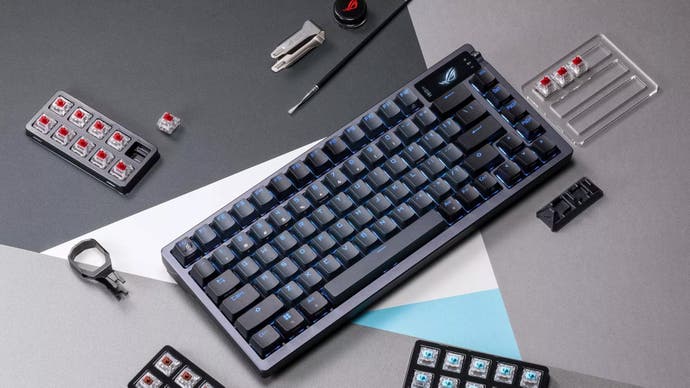Asus ROG Azoth: bridging the gulf between mainstream and custom mechanical keyboards
A feature-packed 75% keeb at an enthusiast price.
For far too long, I've felt there's been too much of a gulf between the mainstream gaming keyboards of this world and the more enthusiast-level options. The world of mechanical keyboards is something that's grown from a niche subculture to a PC gaming standard - even once-enthusiast keyboard forums now record over a million members. With that in mind, companies have tried to make keyboards to appeal to both sides, implementing enthusiast features without losing the traditional gamer aesthetic or core audience.
It's a tricky line to walk, but Asus seem to have nailed it with their new ROG Azoth keyboard. It balances the traditional nerdy charm of a gaming keyboard - with its sumptuous RGB, fun OLED screen and excellent wireless connectivity - with enthusiast nice-to-haves, like hot-swappable switches, a pot of lubricant and a gasket-mounted PCB for a smoother typing feel at lower volumes.
Let's talk design first of all. The Azoth features the usual Asus ROG charm, with its aggressive looks, and the ribbed plastic underside contrasts the grey aluminium top housing nicely, That mix of metal and plastic also allows the build quality here to be absolutely sublime. Even if this is a smaller 75 percent keyboard, the Azoth still tips the scales at 1.2kg or so, which is pretty darn heavy. It should therefore come as no surprise to learn that there is no deck flex at all. Rather, if you experienced any intruders at home, and you wanted to reach for something that could knock them out, the Azoth would be a sure-fire way of doing so... not that I'm suggesting you hit people or anything.

The excellent build quality and thoughtful nature of the Azoth's construction also extends into its PBT keycaps. They feel great under finger with a textured finish that makes this keyboard a joy to use and also help to justify the Azoth's higher price tag a little more, too. Moreover, Asus also included a simple switch on the back of the keyboard to choose between Bluetooth and 2.4GHz wireless modes, rather than making you try to remember an obscure key combo to do the same job; there's also a holder back here for the 2.4GHz USB dongle.
The OLED display in the top corner is also a handy innovation (borrowed from SteelSeries' Apex keyboards) and not only looks cool, but also serves a handy purpose. It's here where you can check on vital information such as the battery percentage as well as controlling things such as media playback, and the Azoth's RGB lighting. The actual display itself is vivid and icons look sharp, while the switch on the top right corner next to it feels snappy and arguably works better than a more traditional volume roller.
It's when you get inside the Azoth that the enthusiast side begins to show a little more, though. There's a shedload of foam underneath the PCB inside the case for dampening the sound and reducing any unwanted case ping - the acoustics of the Azoth are excellent. In addition, its gasket mounting helps to offer a springier but no less satisfying typing experience.
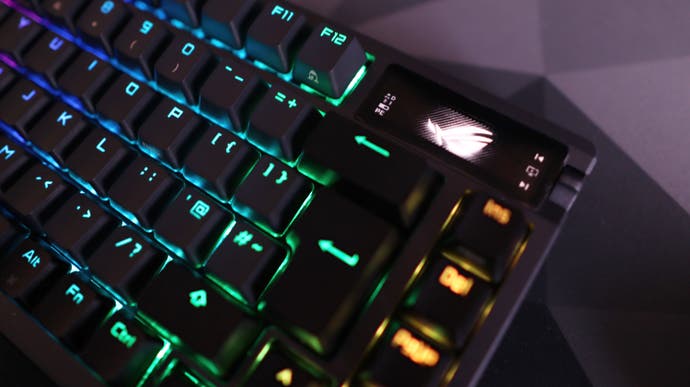
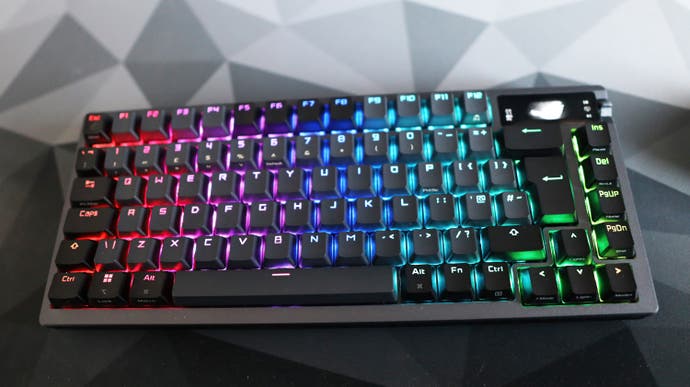
The Azoth utilises pre-lubed NX Red switches, aka Asus' own Cherry MX Red clones, which feel buttery-smooth and aren't scratchy in the slightest. A lot of this is down to the fact that they're pre-lubricated, which helps to deepen their sound as well as smoothen the switches out. If you want to lubricate them any more yourself, there is also a full lube kit inside the box; the first time I've ever seen such a thing included. As light and linear switches with a soft 45g actuation force, they also prove to be a solid choice for gaming. CS:GO is my game of choice, and the NX Reds felt unusually great for a stock switch, I must say.
With that in mind though, you can add any MX-style switches you like, as long as they have the standard 3 or 5 pin mountings, as this board has a hotswappable PCB. Swapping some MX Clear switches I had lying around into the Azoth is as easy, and it completely changes the feeling of the keyboard. Having that flexibility is what makes this a great gateway keyboard for those looking to get into mechanical boards on more of an enthusiast level - without the fiddly nature of soldering and desoldering switches from a PCB.
I must also confess that the wireless connectivity, particularly over the bundled wireless receiver, is brilliant, making the Azoth feel responsive in both day-to-day working and gaming afterwards. There is also the option for Bluetooth, which is kinder on the battery but suffers in terms of latency. Asus quotes the Azoth to last for 130 hours on a single charge when you've got the OLED display on and no RGB, and for over 2000 hours with no OLED display or RGB. That's some pretty serious endurance.
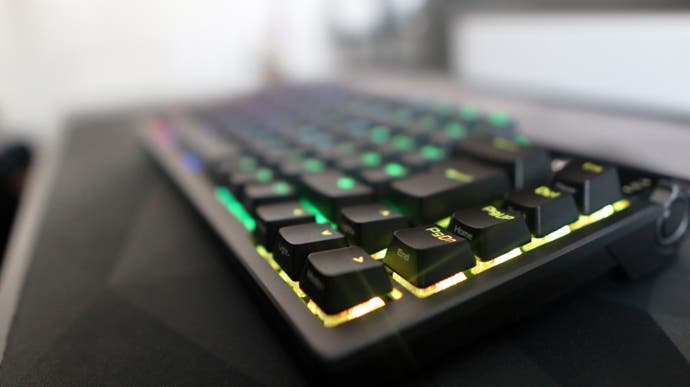

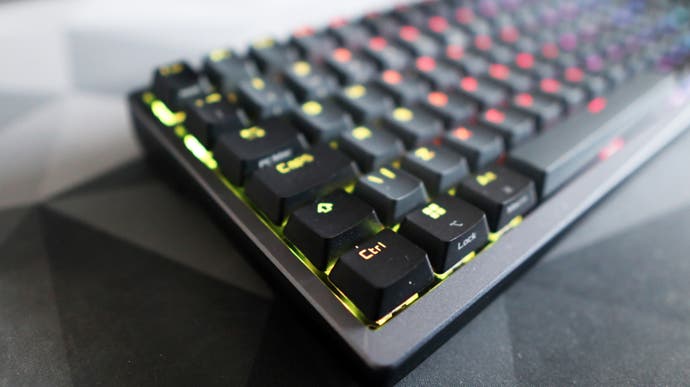
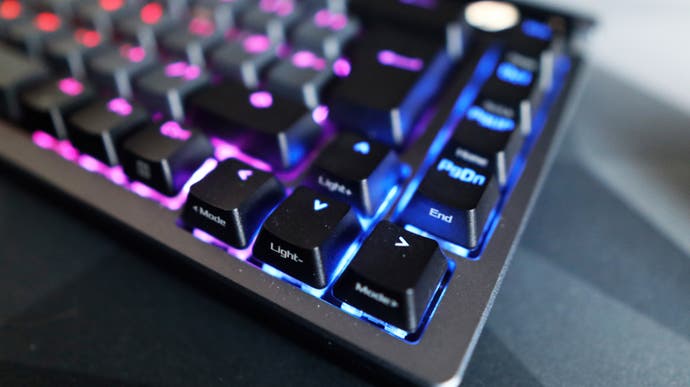
The Azoth's lighting is also vibrant, and looks great, but the bundled Armoury Crate software used to control it is a bit of a pain. It's horribly slow to do anything and sometimes freezes, but the saving grace is the fact the functionality here is probably worth the wait, considering you can control not only that RGB lighting, but also the OLED display to show everything from system information to custom messages.
And then there's arguably the largest bugbear - the price. All of these features mean the Azoth isn't cheap, with a price tag of £270/$250 putting it right up there was one of the dearest keyboards I've tested. Of course, that means it isn't for everyone, especially considering the wealth of more enthusiast-level options from the likes of Keychron that offer a very close feature set to the Azoth for a little over half the price.
With that in mind though, the Azoth is one of those products that'll hopefully set off a trend in bringing more enthusiast style features and functions into the mainstream - and hopefully at significantly more 'mainstream' price points.
For the Azoth itself, it's an expensive keyboard but it might just be worth it for everything you get in the box. And if you decide to change its look or feel down the road, you can swap out its switches, keycaps or cables for something that suits you better. That's the beauty of this hobby, after all.
